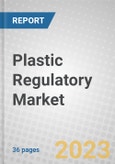Although banning plastic bags is becoming more popular as a policy solution to reduce plastic bag litter, opinions on its justification and efficacy are divided. This study examines the advantages, drawbacks, and unforeseen effects of banning plastic bags. The report identifies countries that have regulations on plastics.
The current report provides detailed exposure to regulatory requirements for plastics manufacture, import, stocking, distribution, and sale. Furthermore, the report also mentions countries where there are limits on thickness of plastic carrier bags.
Report Includes
- A brief general outlook of the global markets for plastics regulations
- Understanding of plastics regulatory and the status of plastic bag policies in North America, Europe, Asia-Pacific, Africa, South America, Central America, and the Caribbean
- Review of the impact of plastic bag bans and instruments most frequently used to address plastic pollution
- Recommendation of actions that could potentially cut down on single-use plastics debris by half
Table of Contents
Executive Summary
The manufacture of plastics has increased steadily worldwide in electronics, insulating buildings, preserving food, and increasing the fuel efficiency of automobiles. Yet, the sheer number of plastics consumed causes a significant production-related carbon footprint, large amounts of waste, ongoing pollution, and harm to the environment and species.
Growing public knowledge of the pervasiveness of plastic pollution has recently influenced public sentiment and prepared the ground for a more aggressive regulatory response. Recently, laws and regulations about plastic have been introduced in several nations, regions, and towns. The main goals are to minimize consumption and enhance waste management through use and disposal. The majority of nations have put restrictions and fees on single-use waste and plastic packaging in place.
Although there are currently no laws or regulations that specifically address the primary production of plastics, businesses that produce the raw materials for plastics (such as oil and gas companies) may be indirectly impacted by laws that increase the recycling of plastic and decrease reliance on fossil fuels and greenhouse gas emissions.
The number of laws and regulations about the use and disposal of plastic has drastically increased, having an effect on businesses along the entire value chain and causing change both upstream and downstream. Recently, laws and regulations about plastic have been introduced in several nations, regions, and towns. The main goals of these are to minimize consumption and enhance waste management through use and disposal.
The most frequent instrument used was regulatory: to ban plastic at some stage in the life cycle. Fundamentally, practically all restrictions were aimed at the marketing or point-of-sale phase of the life cycle of plastic products, then at import and manufacturing.








